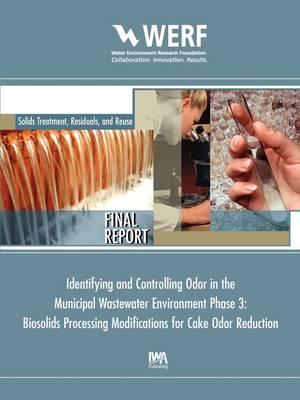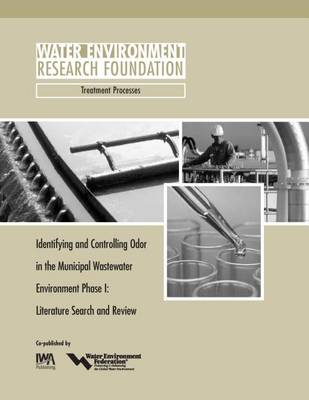WERF Research Report
5 total works
Phase 3 of the overall WERF project was developed to study eight Phase 2 hypotheses in more depth, beginning in the laboratory (bench-scale) studies and continuing on to targeted investigations where the WERF team manipulated plant parameters at full scale to identify the best means of reducing biosolids cake odors. The Phase 3 research specifically sought ways to enhance anaerobicly digested and dewatered biosolids to reduce the odor levels in the biosolids end product, thereby reducing negatively perceived impacts on the environment or to the public when beneficially used on land.
The goal of the Phase 3 study was to provide a general application of findings to WERF subscribers who are seeking ways to reduce odors produced by anaerobicly-digested biosolids. The Phase 3 options summary presents a general roadmap for wastewater treatment plant operators seeking to optimize biosolids processing and reduce biosolids cake odors. Biosolids cakes with minimal odors lead to better public acceptance near biosolids management sites and in neighborhoods adjacent to WWTPs. Reduced odors also could open the WWTP dewatered biosolids cake to other recycling or disposal opportunities that are currently not used due to odor and other concerns (including on-plant site composting or storage). Additionally, significant cost savings could be realized by not requiring extensive odor control or other expensive options for containment and management of biosolids.
The goal of the Phase 3 study was to provide a general application of findings to WERF subscribers who are seeking ways to reduce odors produced by anaerobicly-digested biosolids. The Phase 3 options summary presents a general roadmap for wastewater treatment plant operators seeking to optimize biosolids processing and reduce biosolids cake odors. Biosolids cakes with minimal odors lead to better public acceptance near biosolids management sites and in neighborhoods adjacent to WWTPs. Reduced odors also could open the WWTP dewatered biosolids cake to other recycling or disposal opportunities that are currently not used due to odor and other concerns (including on-plant site composting or storage). Additionally, significant cost savings could be realized by not requiring extensive odor control or other expensive options for containment and management of biosolids.
Identifying and Controlling Municipal Wastewater Odor Phase II
by Gregory M. Adams and Jay Witherspoon
Published 1 March 2004
This project was undertaken in response to needs by the wastewater treatment industry to better understand the generation of odors from biosolids produced by wastewater treatment plants (WWTPs). Its primary objective is to begin to establish relationships between WWTP process parameters and biosolids odors, so that more effective techniques for minimizing biosolids odors can be developed. The project consisted of a detailed field study involving extensive sampling and analyses at 11 WWTPs across North America with capacities from 13 to 350 million gallons per day (mgd). Biosolids samples were collected from the WWTPs at a number of sampling points, which were chosen to represent a complete snapshot of biosolids generation and handling at each WWTP. The sampling points started with influent wastewater, proceeded through primary and secondary clarification, and continued through digestion, dewatering, and onsite storage of dewatered biosolids cake. Laboratory-scale anaerobic storage tests were conducted to simulate odor development of biosolids in storage, prior to their beneficial reuse or disposal. A battery of analyses were performed on the biosolids samples by the participating utility laboratories, commercial laboratories, and specialized university laboratories. The analytical data were evaluated and compared with process and operation parameters at each participating WWTP.
Identifying and Controlling Municipal Wastewater Odor Phase I
by Gregory M. Adams and Jay Witherspoon
Published 1 January 2004
A general review of literature published from 1990 to 2000 and unpublished (gray) literature on odors associated with municipal wastewater collection systems and treatment facilities, including biosolids handling. The literature review focused on several areas including odor characterization technology, odor sampling, analysis, measurement technology, and odor mitigation (control) technology.
Minimization of Odors and Corrosion in Collection Systems
by Jay Witherspoon
Published 30 April 2008
Wastewater collection system odors and corrosion issues continue to grow in importance to the community and to system owners and operators. Odor and corrosion prevention in collection systems has historically been as much art as science. Common control methods are selected based on practical experience as opposed to a fundamental understanding of why and when methods will be successful. Although much is known regarding the cause of odorous gases in the collection system, the underlying science and mechanisms of odor generation, sewer ventilation, odor characterization and monitoring, and corrosion mechanisms need further research. This WERF research activity helps odor-control specialists transition from "odor artists" to scientists and engineers, while also providing a useful tool both for designers to successfully prevent odor and corrosion events through proper design and for operators to mitigate and prevent odor excursions and corrosion impacts.
This project transfers state-of-the-art technology and information gained from the literature survey to the collection system owner and designer on odor and corrosion assessment, measurement, characterization, monitoring, and prevention. The field studies identified in this Phase 1 effort will fill high-ranked knowledge needs. The resultant database and team-developed, web-based application tool will identify the best practices for the entire collection system and its associated facilities, infrastructure, equipment, and pipes. A plain-English guide providing a useful and easily understandable overview about odor and corrosion in collection systems including how odor and corrosion compounds are formed and what to do to control them is provided as an introduction to this document.
This Phase 1 report then summarizes the state of the art in knowledge related to odor and corrosion in collection systems. This highlights the latest knowledge reported in the literature. These efforts to compile the literature database have included information-sharing partnerships with municipal utilities, the academic community, and the profession, all on a global basis. Our team included leading odor and corrosion control researchers in the academic, utility management, and consulting communities, and part of their role was to provide exhaustive literature research efforts through catalogue reference, gray literature review, and Internet search mechanisms. In this way we have accessed a broad spectrum of global resources tapping into the knowledge and experience of both WERF member and nonmember utilities.
This project transfers state-of-the-art technology and information gained from the literature survey to the collection system owner and designer on odor and corrosion assessment, measurement, characterization, monitoring, and prevention. The field studies identified in this Phase 1 effort will fill high-ranked knowledge needs. The resultant database and team-developed, web-based application tool will identify the best practices for the entire collection system and its associated facilities, infrastructure, equipment, and pipes. A plain-English guide providing a useful and easily understandable overview about odor and corrosion in collection systems including how odor and corrosion compounds are formed and what to do to control them is provided as an introduction to this document.
This Phase 1 report then summarizes the state of the art in knowledge related to odor and corrosion in collection systems. This highlights the latest knowledge reported in the literature. These efforts to compile the literature database have included information-sharing partnerships with municipal utilities, the academic community, and the profession, all on a global basis. Our team included leading odor and corrosion control researchers in the academic, utility management, and consulting communities, and part of their role was to provide exhaustive literature research efforts through catalogue reference, gray literature review, and Internet search mechanisms. In this way we have accessed a broad spectrum of global resources tapping into the knowledge and experience of both WERF member and nonmember utilities.
Available as eBook only.
This report presents the methodology and findings of the Collection System Ventilation Research project completed in Phase II of the WERF initiative Minimizations of Odors and Corrosion in Collection Systems. The purpose of the study was to measure air ventilation within full-scale gravity collection system components; simultaneously measure parameters related to ventilation; use the field experimental results to evaluate current ventilation models; and develop a concept for an improved ventilation model. Experiments were completed at four different locations within the Los Angeles and King County wastewater collection systems. Subject components were concrete gravity pipes ranging in diameter from 33 to 96 inches. Air velocity was measured within each pipe using a carbon monoxide pulse tracer method. Air velocity was measured entering or exiting the components at vents using a stand pipe and hotwire anemometer arrangement. Ambient wind speed, temperature, and relative humidity; headspace temperature and relative humidity; and wastewater flow and temperature were measured. All parameters were logged continuously using data loggers.
The field experiments resulted in a large database of measured ventilation and related parameters characterizing ventilation in full-scale gravity sewers. The field data were used as input to three current ventilation models (each using a different technology) to evaluate the models' accuracy compared to the measured field data. Strengths and weaknesses of each model were assessed. Finally, observations from the study were used to develop a concept for an improved ventilation model based on conservation of momentum equations in connected collection system components.
This report presents the methodology and findings of the Collection System Ventilation Research project completed in Phase II of the WERF initiative Minimizations of Odors and Corrosion in Collection Systems. The purpose of the study was to measure air ventilation within full-scale gravity collection system components; simultaneously measure parameters related to ventilation; use the field experimental results to evaluate current ventilation models; and develop a concept for an improved ventilation model. Experiments were completed at four different locations within the Los Angeles and King County wastewater collection systems. Subject components were concrete gravity pipes ranging in diameter from 33 to 96 inches. Air velocity was measured within each pipe using a carbon monoxide pulse tracer method. Air velocity was measured entering or exiting the components at vents using a stand pipe and hotwire anemometer arrangement. Ambient wind speed, temperature, and relative humidity; headspace temperature and relative humidity; and wastewater flow and temperature were measured. All parameters were logged continuously using data loggers.
The field experiments resulted in a large database of measured ventilation and related parameters characterizing ventilation in full-scale gravity sewers. The field data were used as input to three current ventilation models (each using a different technology) to evaluate the models' accuracy compared to the measured field data. Strengths and weaknesses of each model were assessed. Finally, observations from the study were used to develop a concept for an improved ventilation model based on conservation of momentum equations in connected collection system components.



